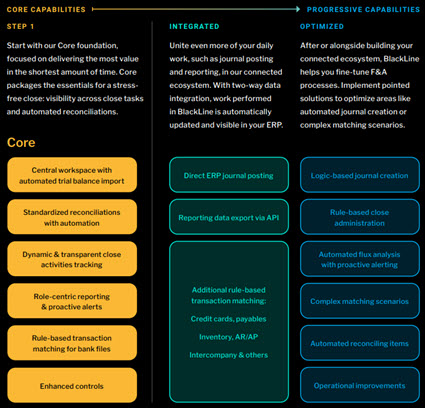Making the Move to Modern Accounting
There are many different ways to describe what is going on in accounting today. One of the better descriptions I have run across is used by Blackline. They call it "making the move to modern accounting" and Blackline provides what they call the modern accounting playbook to help organizations make this move. Here Blackline and SAP explain the benefits. Here Blackline makes the case for continuous accounting.
Others have different descriptions for what is going on. Deloitte calls it "the finance factory". Others refer to what is going on as continuous accounting. Others a finance transformation.
Whatever the term used to describe it, what is going on relates to improving accounting, reporting, auditing, and analysis processes.
No one really explains HOW to implement "modern accounting" in detail. In their Modern Accounting Playbook on page 3 Blackline does provide the following high-level description:
My focus is the complete process. And my focus is not to make a few incremental changes but rather to rethink accounting, reporting, auditing and analysis. I have successfully automated all the way from initial journal entry to generating the external financial reports and many steps in between using a standards-based best practices based method I have created.
A fundamental mistake that far too many accountants make is not entering information into the accounting system at all or late in the accounting process. As The Knowledge Graph Cookbook: Recipes that Work points out, "The basic rule is that context tagging and classification should take place as soon as possible after the content is created."
My second best prototype of the record-to-report process helps me understand and identify several specific things that are fundamentally missing from the typical current accounting process or cause implementing modern accounting more challenging than it really needs to be. For example:
- Poorly implemented chart of accounts.
- What Workday calls "work tags" are missing from accounting systems.
- Information that explains how to aggregate chart of accounts/trial balance information into the financial report line items, subtotals, and totals is not in the accounting system (typically in a report writer).
- Policies are not in the accounting system.
- Information related to quantitative and qualitative disclosures is not in the accounting system.
- Disclosure checklists are human readable (i.e. not machine readable) and therefore not usable in automated processes.
- Other process control information is not available to processes in machine-readable form.
There are a few other odds and ends that are missing but the above should give you a good idea of what I am talking about.
Further, Blackline's process appears to be proprietary (i.e. does not use global standards such as XBRL). That is excellent for Blackline, but it is not good for consumers.
Finally, I don't hear Blackline or others talk about things like Lean Six Sigma process control techniques and philosophies that help control process quality.
So turning this around; imagine something like Blackline connected to Engine B's notion of an always on audit which is also connected to say Workivia's XBRL-based financial reporting tool which is connected to Mindbridge's AI Assisted Audit tool. Information is exchanged between one tool and another virtually friction free because the XBRL standard technical syntax is used. My record-to-report process prototype shows every detail of how to build this.
In my view, this is what accountants should be asking for. The better the questions accountants ask software vendors the better software those vendors will provide.
If you are a tempered radical that is trying to change your organization ping me if you want a link to my best prototype of record to report.
########################
References (1)
-
 Response: Coinbase Vault withdrawal not WorkingIf your Coinbase Vault withdrawal is not working, 800 Phone Numbers can guide you through troubleshooting steps to regain access to your funds.
Response: Coinbase Vault withdrawal not WorkingIf your Coinbase Vault withdrawal is not working, 800 Phone Numbers can guide you through troubleshooting steps to regain access to your funds.


Reader Comments